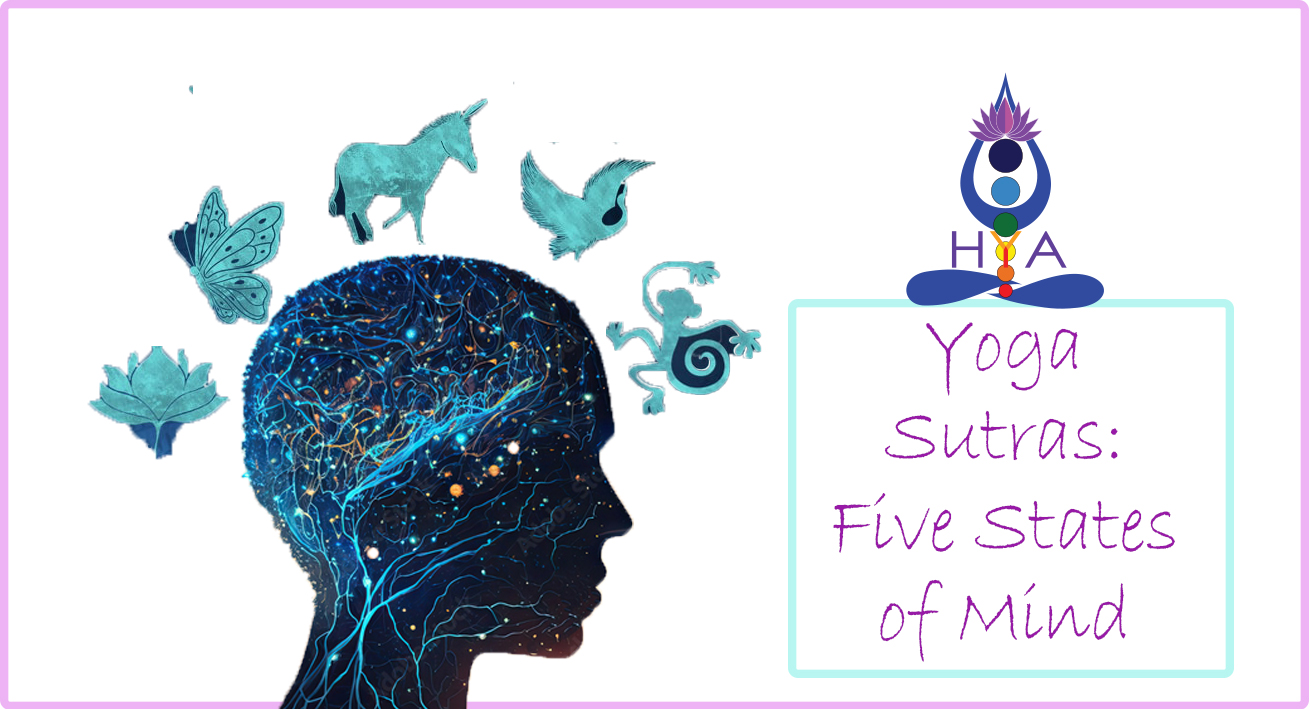
20 Jun 2024 HYN Himalayan Yoga Academy
Three words sum up the aim of yoga for Maharishi Patanjali, the author of the well-known yogic work The Yoga Sutras the cessation (nirodha) of the fluctuations (vrittis) of the mind (chitta). Chitta (mental stuff) is dynamic. It changes all the time. These variations give rise to feelings and ideas that motivate behavior.
Yoga aims to achieve a state of Samadhi when the mind remains peaceful and uncluttered even in the most trying situations. However, The Yoga Sutra teaches that we must first comprehend the various mental states to arrive at this condition of complete peace and harmony.
In the Yoga Bhashya, (the most authoritative commentary on the Yoga Sutras) the great sage Vyasa offered the following classification of the Five States of Mind:
1. Kshipta — the Monkey Mind
A person will be agitated and nervous while they are in this lowest mental state. Kshipta is the incessantly bouncing monkey mind. Extremes of love and hatred, like and dislike, pleasure and agony, and excitement and boredom alternate while one is in this mental state. There is no apparent focus, which makes managing simple tasks difficult. It is the most prevalent mental state while awake, particularly in these hectic, stressful modern times.
Anxiety, restlessness, confusion, trouble making decisions, and lack of clarity are all signs of the kshipta state of mind.
How to Balance Kshipta Mind :
We can learn to accept that thoughts come and go through yoga practice. You can give your mind explicit instructions to stop wandering and concentrate solely on what is necessary at that precise moment by controlling and prioritizing your attention just towards positive, significant, and healthful ideas and letting go of the undesirable ones.
2. Mudha – The Donkey Mind
This is the condition of a dull, lethargic, and sluggish mind. The lack of focus, awareness, and energy required to handle various life events is why it is known as the “donkey state of mind.” This lack of motivation causes a person in this mental state to frequently give up and feel hopeless in difficult situations, which results in failures and unhappiness.
The mudha mental state is characterized by low vitality and energy, difficulty concentrating, melancholy, depression, and a loss of sense of self.
How to Balance Mudha Mind :
The mind must be awakened and given vitality in order to overcome the dull Mudha mind. Using a mudra or mantra in your mindfulness or concentration meditation will help you become more aware and give you the energy you need to move past this stage.
3. Vikshipta – The Butterfly Mind
The mind fluctuates between periods of distraction and clarity when it is in this state. It is not entirely within your ability to regulate your ideas when you are in this frame of mind. While the mind can occasionally feel stable and happy, it can also return to agitated or depressed states during trying circumstances.
The vikshipta mentality is characterized by tranquilly and distraction susceptibility. You can focus more clearly in this mental state than in the mudha or kshipta states, but you still need to practice.
How to Balance Vikshipta Mind :
Frequent yoga and meditation practice might help you become more focused and less distracted while in this state. Additionally, it teaches the mind to unwind, which enables you to extend periods of concentration and find calm during turbulent times.
4. Ekagra — One-Pointed Attention
This is a calm, concentrated state of mind. When one is single-minded, they are not influenced by other forces and are able to concentrate fully.
Better focus, awareness, and clarity are signs of the ekagra condition, which is necessary for meditation, awakening intuition, and experiencing a sense of happiness and wholeness.
How to Maintain of Ekagra Mind :
Yoga is a mental condition that represents oneness with the highest consciousness. When you’re in this position, you’ve discovered a singular life goal that won’t be influenced by outside circumstances. You become acutely aware of extrasensory perception as your intuition is awakened. Maintaining this state can be facilitated by regular yoga practice.
5. Niruddha — Fully Focused Mind
You pass through the Ekagra and arrive at Niruddha, the fifth yoga state of consciousness. This is the mind of a yogi, the trained mind. Your mind is totally calm in this condition and is not being stimulated or disturbed by anything inside or outside of it.
When you are fully immersed in the present moment during meditation, you can achieve a state of pure peace that is symbolized by the tamed Niruddha mind. At this point, all attachments and cravings are released from the mind, and profound serenity and happiness are experienced. Those yogis who can enter and maintain this condition will ultimately achieve samadhi.
Conclusion
The yoga sutras on the five states of consciousness taught by Patanjali are really important for anyone on a path of self-learning and spiritual development. The way to quiet and self-awareness is illuminated by the Chitta bhumis, who acts as a beacon of light. We can rise above the limitations of the human mind and ultimately discover our true selves by mastering these yogic states of consciousness: Kshipta (distracted), Mudha (dull), Vikshipta (partially focused), Ekagra (one-pointed), and Niruddha (completely controlled).
